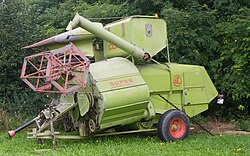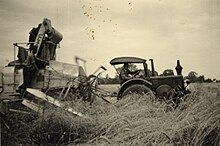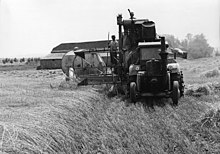Claas great
| Claas Brothers Maschinenfabrik | |
|---|---|

Claas Super Automatic |
|
| Claas | |
| Manufacturer: | Claas |
| Sales designation: |
Super (1946–56) Super 500 (1956–78) Super Automatic (1958–78) |
| Production period: | 1946-1988 |
| Engines: | Petrol engines: VW Type 122 , (1,192 cm 3 , 17–22 kW) diesel engine: 22 kW |
| Length: | 6,500 mm |
| Width: | 5,700 mm |
| Height: | 3,700 mm |
| Standard tires: | 13-14 AM |
| Separation system: | Vibrating shaker |
| Threshing system: | Tangential |
| Cutting width: | 2.1 m |
| Threshed material unloading: | in sacks or from the grain tank via the unloading auger |
| Grain tank volume: | 1.1 m 3 |
| Dimensions: | 2,400 kg |
| Previous model: | MDB |
| Successor: | none |
The Super is a trailed combine harvester from Claas . Series production started in 1946. Walter Brenner presented the first Claas Super, also publicly known as the “new Mäh-Thresch-Binder ”, to officers of the British military government and representatives of the German authorities on the premises of Claas . From 1953 a smaller counterpart was offered under the name Super-Junior , the basic model was marketed in a technically revised version as the Super 500 from 1956 . In 1958 the Super Automatic followed , which has a hydraulic system for adjusting the height of the cutting unit as well as a reel height adjustment. Production was stopped in 1978 after around 65,000 machines had been built.
History and Development
Claas had built the MDB until the war-related cessation of production in 1943 , a trailed combine harvester that threshed the grain across the direction of travel and fed it to the residual grain separation system. The developer of the Claas combine harvesters, Walter Brenner, had a "super idea" on December 8, 1942, from which the name of the Claas Super comes. Since a combine harvester requires an improved threshing drum and a larger separation system to increase its output, the external dimensions inevitably increase. With a pure cross-flow combine, such as the MDB, this would have meant an increase in the width of the vehicle, which would have severely impaired transport and use on small parcels. Brenner sketched a combine harvester that threshed the grain transversely to the direction of travel, but then pulled it upwards, turned it and thus fed the residual grain separator along the direction of travel.
Several of these experimental machines were built before the end of World War II and tested in Westphalia. After a Super was confiscated by the British military government and brought to the United Kingdom, Claas feared that the Super would be reproduced there, as no patents had yet been registered for the thresher. Against fear, the thresher was only tested and not copied. After the Second World War, several Claas Super 1946 were brought to the Rhineland for the rapid harvest campaign in order to be able to harvest the grain there. Claas used the experience to develop the Super for series production. The Super quickly developed into a sales success for Claas.
Claas continuously developed the Super, so the grain tank and unloading pipe were soon part of the standard equipment, from 1953 there was the Super with auxiliary motors, from 1958 Claas offered the Super Automatic with hydraulic cutting unit. This one no longer has a straw press. Compared to the self-propelled combine harvester, the Super offered advantages in terms of purchase price; in 1951 its purchase price with an auxiliary engine was DM 12,454, while the self-propelled Europa with the same threshing capacity cost around DM 24,000.
technology
The Super is a trailed, single-axle combine harvester that can be used for combine threshing, swath threshing, crouch threshing and standing threshing. It is available with and without a motor. The motors are mounted as add-on motors on the roof above the threshing drum (see picture below right). If the motorless Super (see picture on the left) is to be used for combine harvesting, a tractor with at least 35 HP (approx. 26 kW) is necessary (or 28 HP (approx. 21 kW) when using the crawler gear) to pull the Super and to drive his threshing mechanism via the PTO shaft . The Super could be supplied with a 23 HP (17 kW) built-on gasoline engine that drives the threshing mechanism together with the engine of the towing tractor; it is primarily designed for tractors with an engine power of around 25 HP (approx. 18 kW). The range also included two 30 HP (approx. 22 kW) engines, a petrol and a diesel engine. They drive the threshing mechanism of the Super without the help of the pulling tractor and are designed for tractors from 20 HP (approx. 15 kW). If the Super is used for floor threshing, a tractor with 15 kW engine power is sufficient to drive the threshing mechanism.
The Super has a 2100 mm wide cutting unit that is attached to the front right of the machine. It is designed so that it mows next to the pulling tractor and the tractor does not have to drive through the grain to be harvested (see picture on the left). The cutting unit has a reel and a helical rotating stalk divider. The mown grain is conveyed to the threshing device on a conveyor belt across the direction of travel. The Super-Automatic models have a hydraulic system with which the cutting unit and reel can be adjusted in height independently of one another. It was connected to the power take-off shaft of the towing tractor for this purpose. The Super 500 models, on the other hand, were only available with a so-called reel automatic , in which the height of the reel could be adjusted by the tractor driver using a cable pull. For transport, the cutting unit is tilted to the left by approx. 90 ° so that it rests on the front of the combine (see picture above right). For primarily foreign markets, the Super was also available with a 2400 mm and 3000 mm wide cutting unit; for swath threshing there is a pick-up drum that can rotate at three preset speeds.
The threshing drum with six beater bars and a diameter of 450 mm is built into the thresher lengthways to the direction of travel, while the residual grain separation also works with a lengthwise walker; The Super thus works according to the cross-longitudinal flow method: the grain is transported laterally, i.e. across , over the conveyor belt to the right-hand threshing drum (viewed from the rear) and from there not thrown backwards, but upwards onto the turning head, which carries the straw conveyed backwards in the thresher, i.e. lengthways , onto the shaker. Optionally, deburring plates could be installed over the threshing drum. The concave is not attached under the threshing drum, but shifted about a quarter of a turn clockwise because the threshing drum works upwards. The concave has no torque adjustment. The speed of the threshing drum can be continuously adjusted between 1100 and 1350 min −1 by changing the belt drive. With change gears, the translation and rotation speeds from 500 to 1400 can be changed, so min -1 are possible.
The residual grain is separated using a 3000 mm long vibrating shaker. The Super has an adjustable pressure wind blower and upper and lower sieve. The sieves are suitable for all types of grain, oilseeds, pulses, clover seeds and fine seeds. The material that leaves the shaker and the material from the sieves can be fed back into the threshing drum; the Super has a double return . The chaff can be collected in the chaff pan and either blown into a chaff wagon with a chaff blower or filled into sacks with a cyclone on the roof. As standard, the grain is transported with the elevator to the roof of the thresher, where it is sorted into three quality classes in a sorting cylinder and filled into sacks. The sacks can be temporarily stored on the roof of the thresher and either parked in the field or unloaded onto a trailer using a slide. A grain tank with a capacity of approx. 1000 kg of grain was also available as additional equipment for the Super. The grain tank can be emptied into a trailer with an auger, on request a bag filling from the grain tank was still available. On average, the Super should be able to harvest 2000 kg of grain in one hour.
The straw is pressed by a reciprocating piston straw press into approximately 1000 mm long, twice tied straw bundles with a weight of 10-25 kg. Optionally there was a straw cutter which cuts the straw into 10–20 cm long stalks and then throws it onto the field. The straw cutter was also available together with the straw press, so that the straw could either be pressed into bales or cut into short stalks. The straw cutter had to be dismantled for baling bales, while cutting the straw into stalks does not require dismantling the straw press.
Remarks
- ↑ The source mentions "18 HP or 15 kW" here, a conversion error is likely here. Either “20 HP or 15 kW” or “18 HP or 13 kW” would be correct.
source
literature
- Jürgen Hummel, Alexander Oertle, Jan Sternberg, Peter Felser: Combine harvesters: history and technology . wk & f Kommunikation, Kempten 2008, ISBN 978-3-89880-417-2 , p. 32-34 .
- Manfred Baedecker, Ralf Lenge: The Claas combine harvester story . 2nd Edition. Landwirtschaftsverlag, Hiltrup 2003, ISBN 978-3-7843-3053-2 , p. 42-49 .
Web links
Individual evidence
- ↑ A new mowing-threshing binder . In Westfälische Nachrichten , issue Wa. August 3, 1946.
- ↑ a b combine harvester: history and technology, p. 33.
- ↑ MDB to Matador - 1946–1978: SUPER - the VW Beetle among combine harvesters ( Memento from September 11, 2016 in the Internet Archive )
- ↑ a b M. Baedecker, R. Lenge, p. 42.
- ↑ M. Baedecker, R. Lenge, p. 44.
- ↑ M. Baedecker, R. Lenge, p. 46.
- ↑ M. Baedecker, R. Lenge, p. 47.
- ↑ The new "Super" 500, p. 8.


